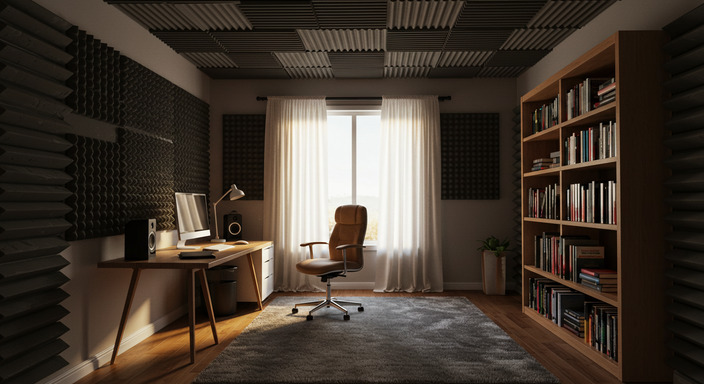The Quiet Quest: What Exactly Is a Soundproof Room?
Have you ever wondered how serenely peaceful it would be to retreat to a completely quiet room, free from the intrusive sounds of the outside world? A soundproof room, often referred to as a haven of silence, provides an escape from the cacophony of everyday life. This concept has evolved significantly with advances in building materials and techniques, allowing individuals to recreate a sanctuary of calm right within their homes. The demand for soundproof rooms has seen an uptick, especially with the rise of remote work and digital content creation, where noise control is crucial.
Soundproofing is not just about muting external noises; it’s about creating a controlled acoustic environment. From recording studios to home offices and even bedrooms, the application of soundproofing materials and methods varies, highlighting the adaptability and necessity of these spaces in today’s noisy world.
Understanding Soundproofing: A Closer Inspection
To comprehend the concept of soundproofing, it’s crucial to delve into the principles that govern it. Soundproofing aims to reduce, block, or isolate sound waves using various materials and construction methods. The effectiveness of soundproofing largely depends on the density and thickness of the materials used.
| Term | Definition | Application |
|---|---|---|
| STC Rating | Sound Transmission Class | Measures sound isolation effectiveness |
| Mass-Loaded Vinyl | Dense, flexible material | Used in walls, ceilings, floors |
| Resilient Channel | Structural component | Prevents direct contact & vibration |
| Acoustic Foam | Sound-absorbing material | Reduces echo and reverberation |
| Green Glue | Viscoelastic compound | Dampens sound within walls |
The soundproofing process can involve decoupling, absorption, damping, and adding mass. Each approach addresses a different aspect of sound control, and the choice of method depends on the specific requirements of the space being treated. Understanding and choosing the right materials and methods is crucial in achieving the desired level of soundproofing.
Applications of Soundproof Rooms: From Studios to Sanctuaries
Soundproof rooms serve a variety of functions beyond simply blocking out noise. Recording studios represent the most well-known application, where controlling sound reflection and isolation is necessary to produce high-quality audio recordings. The precision in acoustic engineering required for such spaces ensures that every sound captured is pure and untainted by external or internal reflections.
Homes also benefit significantly from soundproofing, as soundproofed rooms can be used as offices, gaming rooms, or simply quiet places for relaxation. With remote work becoming more prevalent, having a designated quiet space at home can improve productivity and mental health. Soundproofing techniques vary in residential applications, accommodating the unique requirements of each setting, from urban apartments to suburban homes.
“Soundproofing a room is tantamount to creating a canvas of absolute silence on which you can paint sounds without interference.”
Beyond recording studios and home applications, soundproofing is essential in other environments such as schools, hospitals, and offices. Libraries employ soundproofing to maintain quiet zones, hospitals use it to ensure patient recovery areas are serene, and offices use it to limit noise distractions in open-plan areas.
The Science and Art of Acoustic Treatment
While soundproofing focuses on keeping sound from entering or escaping a room, acoustic treatment addresses the control of sound quality within that space. Acoustic treatment is an art guided by science, using absorbers, diffusers, and bass traps to refine the acoustics of a room, ensuring clarity and naturalness of sound.
1. Absorbers are used to minimize echoes and reverberations, making sounds more distinct and comfortable.
2. Diffusers scatter sound waves, breaking up reflections that can create unwanted resonances.
3. Bass traps target low-frequency sound waves, which can build up and cause imbalances in sound reproduction.
Incorporating acoustic treatment into soundproof rooms elevates the auditory experience, ensuring that sound waves behave as intended, whether for music production or simply enjoying a home theater.
The Role of Modern Technology in Soundproofing
Technological advancements have dramatically affected soundproofing solutions, making them more effective and accessible. Modern innovations include soundproofing panels that integrate active noise-cancelling technologies, similar to high-end headphones, actively counteracting sound waves that enter the room. This advanced method provides additional layers of protection against unwanted noise.
Smart materials that adapt dynamically to the sound environment also represent the cutting edge of soundproofing. These materials change their acoustic properties in response to varying sound levels and frequencies, optimizing the room’s acoustic characteristics automatically.
Economic and Environmental Considerations in Soundproofing
The cost of soundproofing can vary widely based on factors such as room size, the level of sound isolation desired, and the choice of materials. While the initial investment might seem substantial, the long-term benefits, such as increased property value and enhanced quality of life, often justify the expense.
From an environmental standpoint, manufacturers are increasingly focused on producing eco-friendly soundproofing options. Recycled materials, non-toxic adhesives, and sustainable manufacturing processes are becoming prevalent, offering an eco-conscious alternative to traditional methods.
Design Aesthetics in Soundproof Rooms
When integrating soundproofing solutions, aesthetic appeal is an essential consideration. Historically, soundproofing materials were bulky and unappealing, often dictating the room’s design. However, contemporary design solutions prioritize both functionality and style.
Acoustic panels now come in various textures, patterns, and customizable options, allowing them to integrate seamlessly into the existing decor. This fusion of design and function ensures that the visual appeal of a room is not sacrificed for the sake of sound isolation.
Challenges and Misconceptions in Soundproofing
Soundproofing can be deceptively complex, and several misconceptions often lead to suboptimal results. One common misunderstanding is that soundproofing is achieved solely through sound-absorbing materials, like placing foam on walls. However, true soundproofing requires a comprehensive approach, including managing structural vibrations and sound leaks.
Challenges in soundproofing also arise from existing architectural constraints, limited budgets, and a lack of understanding of acoustic principles. It’s crucial to seek expert advice to navigate these complications effectively and achieve satisfactory outcomes.
FAQ – Common Questions
What is the difference between soundproofing and acoustic treatment?
Soundproofing prevents sound from entering or leaving a room, while acoustic treatment focuses on managing sound quality within the space.
Can all types of rooms be soundproofed?
Most rooms can be soundproofed to an extent, but the effectiveness may vary based on the room’s structure and materials.
Is soundproofing expensive?
The cost can vary, but investing in soundproofing can enhance property value and quality of life, often justifying the expense in the long run.
How long does it take to soundproof a room?
The timeframe depends on the room size and soundproofing extent, ranging from a few days to a couple of weeks.
Are there eco-friendly soundproofing options?
Yes, many manufacturers offer sustainable solutions, including recycled materials and non-toxic adhesives.
Conclusion
In our modern, fast-paced world, the luxury of peace and quiet is more valuable than ever. Soundproof rooms, through a blend of technological advancements and acoustic engineering, offer a respite from the noisy outdoors, enhancing productivity, relaxation, and the overall quality of life. As technology progresses, the methods and materials of soundproofing will only improve, making the art of creating silence more accessible and effective than ever before.
Meta Descrição: Discover the intricacies of soundproof rooms, where technology, design, and acoustics converge to create serene and productive spaces.







